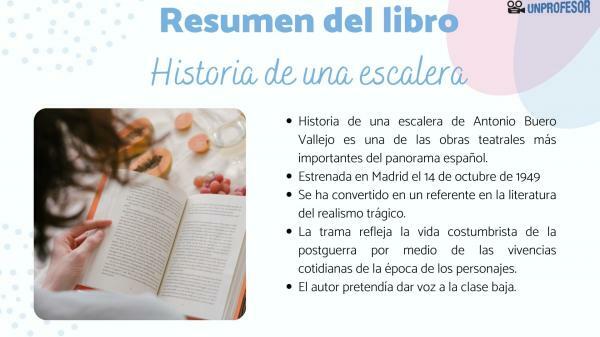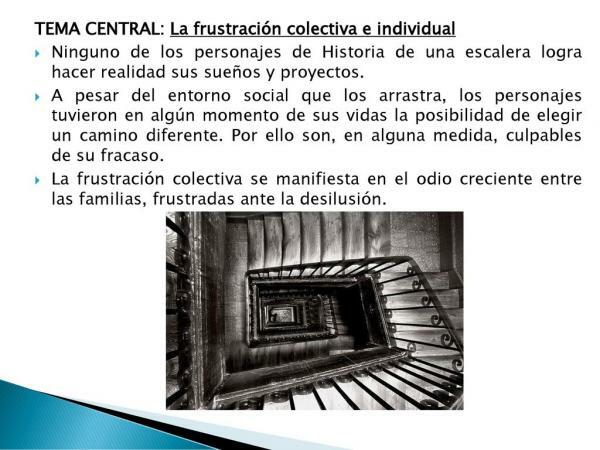History of a ladder: SUMMARY by acts

History of a ladderis one of the most important theatrical works of the Spanish panorama. Premiered in the capital on October 14, 1949, and written in the previous two years by Antonio Buero Vallejo, it has become a benchmark in the literature of tragic realism. In it we see the postwar life of manners reflected through the daily experiences of the time of the characters.
Thus, the author intended to give a voice to the lower class. With all this, and added to the importance shown by the work in current times, in a Professor we have decided to carry out a brief summary of History of a ladder. Can you come with us?
Index
- Summary of Story of a Ladder: Act 1
- Act 2 of Story of a ladder
- Act 3 of Story of a ladder - summary
Summary of History of a ladder: Act 1.
History of a ladder is a work divided into three acts that begins with the light collector appearing on the stairs to do his job, billing the entire community of neighbors. It is through this resource that all the characters of the first act are presented to us, through the interaction they have with the collector. Thus, we can find people with different ways of being who react to the presence of this character in different ways.
The core of the first part arrives with Mrs. Kind (or Doña Asunción), who feels distressed about not being able to pay the bill, which makes the collector seem quite aggressive and angry. Elvira, in love with Fernando (Doña Asunción's son), asks her father in her ear to pay the lady's monthly bill. Don Manuel accepts his daughter's request and agrees to take charge of the situation, finally paying the collector his share and that of Doña Asunción.
What's more, Elvira asks her father for a favor again regarding Doña Asunción's family, begging him to give her son a job. Fernando has spent some time working in a stationery store that does not make him happy or provide him with sufficient financial support to support his needs and those of his family. That is why the boy dreams of getting out of that situation and becoming a draftsman.
Later, Fernando meets his friend Urbano on the stairs, to which he shows his dissatisfaction with his current employment situation. Smoking, they talk about Fernando's dreams and the conversation is steeped in ideological overtones of the characters, defenders of unionism and associationism, always in favor of the working class. Later, Fernando decides to declare himself to Carmina, another of the neighbors with whom he is in love.
Act 2 of Story of a ladder.
In the second act the years have passed and Fernando is married for economic interest with Elvira (since his family was richer than the boy's). In addition, they have created a family with the arrival of their first son, also named Fernando. Despite everything, the family remains poor and unhappy.
The father has become a boastful and grumpy lazy and Elvira couldn't be more saddened by the situation in which he finds himself at the moment, since when he lived with his father everything was much more easy. And it is that, both Elvira and Fernando, have suffered a great loss, since Don Manuel (Elvira's father) and Doña Asunción (Fernando's mother) have passed away.
Gregorio, Generosa's husband and father of Carmina and Pepe, has passed away, which makes both women and the boy very sad. Pepe is married to Rosa, who also has her family among the group of neighbors on the staircase. This is an alcoholic and womanizer who is not happy nor does he make his wife happy. This situation is gradually consuming both characters and their relationship.

Image: Slideplayer
Act 3 of Story of a ladder - summary.
To finish this summary of History of a staircase we come to the third act that starts about 20 years later of what happened in the previous act.
All characters have grown up, married or had children. For example, Carmina has had a daughter with Urbano, Fernando's friend, who has been baptized as his mother. Similarly, Fernando and Elvira have had their second child, whom they have named Manolín.
Many new characters have come to live on the staircase, but they do not stop showing their discontent with the old neighbors, who for the viewer or reader are already known. However, the plot of this last act revolves around to Fernando and Camila children. These, like their parents, begin to live a romance that is not entirely accepted by Fernando father and Camila mother.
In fact, showing his anger, Fernando Sr. begins to argue with Camila, his old romance due to the fact of the relationship that is being born between his children. Finally, as the closing of the work, Fernando Jr. declares himself to the young Camila, filling her life with a promising future.
All in all, both characters they decide to look for a life together, leading the relationship, unconsciously, to make the same mistakes as their parents.

Image: Slideplayer
If you want to read more articles similar to History of a ladder: summary, we recommend that you enter our category of Reading.
Bibliography
- Anton, A (s.f.). Summary of History of a ladder. Studento.com
- Arcoya, E. (s.f.). Brief summary of "History of a staircase" by Antonio Buero Vallejo. Actualidadliteratura.com
- Buero Vallejo, A (1949). History of a ladder. Southern.



